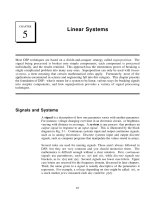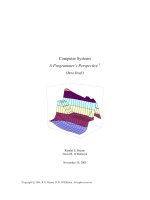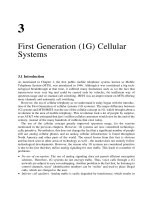Trauma Scoring Systems
Bạn đang xem bản rút gọn của tài liệu. Xem và tải ngay bản đầy đủ của tài liệu tại đây (151.16 KB, 8 trang )
Trauma Scoring Systems
Author: Timothy H Pohlman, MD, FACS, Professor, Section of Trauma and Critical Care, Department of Surgery, Indiana University School of Medicine; Director, Surgical Critical Care,
Methodist Hospital, Clarian Health Partners, Inc
Coauthor(s): H Scott Bjerke, MD, FACS, Clinical Associate Professor, Department of Surgery, Indiana University School of Medicine, Medical Director of Trauma Services, Methodist
Hospital, Clarian Health Partners, Inc; Patrick Offner, MD, MPH, Chief, Surgical Critical Care, Department of Surgery, Trauma Services, St Anthony Central Hospital
Contributor Information and Disclosures
Updated: Jul 23, 2009
/>Introduction
Characterization of injury severity is crucial to the scientific study of trauma, yet the actual measurement of
injury severity began only 50 years ago. In 1969, researchers developed the Abbreviated Injury Scale (AIS)
to grade the severity of individual injuries. Since its introduction, by the Association for the Advancement of
Automotive Medicine (AAAM) International Injury Scaling Committee (IISC), the parent organization of the
AIS modified the AIS, most recently in 2005 (AIS-2005). The AIS is the basis for the Injury Severity Score
(ISS), which is the most widely used measure of injury severity in patients with trauma. Attempting to
summarize the severity of injury in a patient with multiple traumas with a single number is difficult at best;
therefore, multiple alternative scoring systems have been proposed, each with its own problems and
limitations.
This article reviews the conceptual and statistical background necessary to understand injury severity
scoring, presents the most common scoring systems, and addresses new ideas and trends in trauma
scoring.
Applications of Trauma Severity Scoring
An accurate method for quantitatively summarizing injury severity has many potential applications. The ability
to predict outcome from trauma (ie, mortality) is perhaps the most fundamental use of injury severity scoring,
a use that arises from the patient's and the family's desires to know the prognosis. More recently, physicians
suggested that injury severity scoring can provide objective information for end-of-life decision-making and
resource allocation. Trauma mortality prediction in individual patients by any scoring system is limited and is
in general no better than good clinical judgment. Therefore, decisions for individual patients should never be
based solely on a statistically derived injury severity score. However, scoring systems can serve to estimate
quantitatively the level of acuity of injured patients that are applied to adjustments in hospital outcome
assessments.
Field trauma scoring also is used to facilitate rational prehospital triage decisions, thereby minimizing the
time from injury occurrence to definitive management. Similarly, physicians suggest that it can enhance
appropriate use of helicopters and timely transfer of severely injured patients to trauma wards. Trauma
scoring also is used for quality assurance by allowing evaluation of trauma care both within and between
trauma centers, a contentious and controversial area that is likely to only increase in importance.
Perhaps the most important role for injury severity scoring is in trauma care research. Scientific study of the
epidemiology of trauma and trauma outcomes would not be possible otherwise. Injury severity scoring is
indispensable in stratifying patients into comparable groups for prospective clinical trials. Similarly, this
technique can be used retrospectively to identify and control for differences in baseline injury severity
between patient populations.
Basic Statistical Concepts
Fundamentally, trauma outcome prediction is a multivariate problem. Researchers use multiple independent
variables (eg, age, injury severity) to predict the dependent variable (or outcome). Most physicians are
familiar with the simplest form of regression analysis, simple linear regression, which describes the linear
relationship between 2 variables. Multiple regression is an extension of this technique, in which more than
one independent variable is used to describe a single, continuous dependent variable. Multiple regression is
advantageous because it allows one to measure the association between a predictor variable and an
outcome variable while controlling for other modifying factors. Researchers use multiple regression,
therefore, to control for the effects of many variables and assess the independent effect of a single variable.
In trauma severity scoring, mortality is the outcome that has elicited the most interest. Mortality is a
dichotomous variable having only 2 possible values, death or survival. Although several methods are
available, multiple logistic regression is the most popular approach when the outcome of interest is
dichotomous because of some unique advantages of multiple logistic regression.
Odds is a ratio of the probability that a certain event under consideration will occur to the probability that it will
not occur.
As an example, out of 100 patients aged 65-74 years who sustain blunt abdominal trauma, 10 will die, while
out of 50 patients aged 75-84 years, 15 will die. The probability of death in the age group of 65-74 years is
20/100=0.2 (20%) and in the age group of 75-84 years is 15/50=0.3 (30%).
Therefore, the odds of a patient who is between the ages of 65-74 years dying after blunt trauma is 0.2/1-
0.2=0.25 (25%). In contrast, the odds of a patient who is between the ages of 75-84 years dying after blunt
trauma is 0.3/1-0.3=0.4 (40%).
If the probability of an event occurring is equal to the probability that it will not occur, then the odds that the
event will occur is 0.5/1-0.5=1 (eg, the odds of “heads” appearing after tossing a coin is 1).
A ratio of two odds is called an odds ratio. A ratio of two odds greater than 1.0 indicates an increased risk for
the outcome, whereas an odds ratio of less than 1.0 indicates a decreased risk or protective effect for the
outcome. For each age group, one group is typically classified as the reference group and comparisons are
made to this group.
For example, the age group of 65-74 years could be used as the reference group because it is expected that
increasing age would be associated with a greater possibility of dying after blunt abdominal trauma. To
compare the age group of 65-74 years with an older age group, odds ratios are calculated. The odds of the
age group of 75-84 years divided by the odds of the age group of 65-74 years produces an odds ratio of 1.2
(0.3/0.25). With an odds ratio of greater than 1.0, this suggests that patients between the ages of 75-84 years
are 1.2 times more likely to die after blunt abdominal trauma when compared to patients between the ages of
65–74 years.
Logistic regression analysis is a statistical tool that uses these types of analyses to explore the relationship
between multiple variables and outcomes. Mathematical models can then be constructed based on
identification of clinical parameters that predict outcome. Most clinical scoring systems are based on these
types of mathematical modeling. Any clinical variable that has been given a particular score will effect the
determination of outcome (almost always either alive or dead) based on the influence of that clinical variable
itself on mortality and the influence of other clinical variables.
Logistic regression is mathematically convenient in that one can easily convert the coefficients of the
equation into estimates of the risk of developing a disease or outcome given the presence of a particular risk
factor. Researchers adjust these risk estimates for the effects of other risk factors or covariates included in
the logistic regression equation.
Outcome prediction never will be perfect, in part because injury severity is difficult to quantify. Perhaps more
important is that the patient's response to injury is complex and difficult to model adequately; therefore,
multiple scoring systems emerged.
Practitioners should be able to assess the predictive performance of each system in order to compare them.
Measures of predictive performance include explanatory power, discrimination, and calibration.
Explanatory power is that proportion of the prediction outcome that can be explained by the model rather
than by variation. This is reflected by the coefficient of determination (r
2
).
Discrimination is the ability of the model to separate the patients into 2 groups; for example, those who
survive and those who die. This involves sensitivity, specificity, and accuracy, which are concepts well
understood by most physicians. However, when applied to predictive models, these concepts can be
problematic. A trauma survival predictive model yields a probability of survival; while in reality, patients can
only live or die. Therefore, a prediction rule must be established; typically, researchers assign a cutoff point
of 0.5. Patients with a probability of survival greater than 0.5, therefore, are predicted to have lived, while
those with a probability of survival less than or equal to 0.5 are predicted to have died. The problem is that
sensitivity, specificity, and accuracy all vary depending on a prediction rule chosen.
Receiver operating characteristic (ROC) curve analysis can help evaluate the accuracy and discrimination of
a predictive model over a wide range of cutoff points. The ROC curve is constructed by plotting the sensitivity
on the y-axis and (1 - specificity) on the x-axis at different cutoff points. The area under the ROC curve
measures the accuracy of the model. A straight line arising from the origin at a 45° angle has an area under
the curve of 0.5 and represents accuracy no better than flipping a coin. A perfect predictive model has an
area under the curve of 1.0. As accuracy and discrimination improve, the ROC curve moves upward and to
the left. ROC curves allow one to compare different predictive models used in the same population of
patients.
Calibration is the ability of the model to correctly predict outcome over the entire range of risk. Calibration can
be assessed graphically by plotting the actual outcome against the predicted outcome. Calibration is
assessed statistically by goodness-of-fit testing, most commonly the Hosmer-Lemeshow test. This test
involves grouping patients into risk categories and using a modified chi-square analysis to compare the
observed and predicted outcomes in each group. The hypothesis tested is that the model's predictions are
the same as the actual outcome; therefore, higher P values are desired and reflect a good fit.
Physiologic Scores
The Revised Trauma Score (RTS) is one of the more common physiologic scores. It uses 3 specific
physiologic parameters, as follows: (1) Glasgow Coma Scale (GCS), (2) systolic blood pressure (SBP), and
(3) respiratory rate (RR).
The magnitude of physiologic derangement in each parameter is scored from 0-4. The RTS has 2 forms
depending on its use. When used for field triage, the RTS is determined by adding each of the coded values
together. Thus, the RTS ranges from 0-12 and is easily calculated. See Table 1.
Table 1. Revised Trauma Score
Open table in new window
Coded Value GCS SBP (mm Hg) RR (breaths/min)
0 3 0 0
1 4-5 <50 <5
2 6-8 50-75 5-9
3 9-12 76-90 >30
4 13-15 >90 10-30
Coded Value GCS SBP (mm Hg) RR (breaths/min)
0 3 0 0
1 4-5 <50 <5
2 6-8 50-75 5-9
3 9-12 76-90 >30
4 13-15 >90 10-30
An RTS of less than 11 is used to indicate the need for transport to a designated trauma center. The coded
form of the RTS is used more frequently for quality assurance and outcome prediction. The coded RTS is
calculated as follows, in which SBPc, RRc, and GCSc represent the coded values of each variable:
RTSc = 0.9368 GCSc + 0.7326 SBPc + 0.2908 RRc
Obviously, this value is more complicated to compute, which limits its usefulness in the field. The main
advantage of the coded RTS is that the weighting of the individual components emphasizes the significant
impact of traumatic brain injury on outcome.
The RTS has several limitations that affect its usefulness, and most of these limitations are related to the
GCS. As originally described, the GCS was intended to measure the functional status of the central nervous
system. Because of the importance of head injury in determining trauma outcome, the GCS also is used by
many as a component of trauma severity scoring. Problems inherent to the GCS (and RTS) include the
inability to accurately score patients who are intubated and mechanically ventilated (which can often happen
prior to making a triage decision).
Moreover, patients who are pharmacologically paralyzed or who are under the influence of alcohol or illicit
drugs also are difficult to score. Alternative approaches in this setting include using the best motor response
and the eye-opening response to calculate or predict the verbal response. Research has shown that
substitution of the best motor response for the GCS results in no loss of predictive capability. More recently,
researchers have shown that the best motor response predicts trauma mortality as well as or better than
other trauma severity scores.
Acute Physiology and Chronic Health Evaluation
The Acute Physiology and Chronic Health Evaluation (APACHE) was introduced in 1981. APACHE
characterizes trauma patients inadequately, although different versions of this scoring system are used
widely for the assessment of illness severity in surgical intensive care units. This system has 2 components,
as follows: (1) the chronic health evaluation, which incorporates the influence of comorbid conditions (eg,
diabetes mellitus, cirrhosis, chronic renal failure, heart disease malignancy), and (2) the Acute Physiology
Score (APS).
The APS consists of weighted variables representing the major physiologic systems, including neurologic,
cardiovascular, respiratory, renal, gastrointestinal, metabolic, and hematologic variables. In 1985, the
APACHE system was revised (ie, APACHE II) by reducing the number of APS variables from 34 to 12,
restricting the comorbid conditions, and deriving coefficients for specific diseases. A representative
calculation for a hypothetical patient is shown in Table 2.
Table 2. Representative APACHE II Calculation for Hypothetical Patient
Open table in new window
Parameter Representative Measure APACHE II Value
Glasgow Coma Scale 13 2
Age 56 3
Mean arterial pressure (mmHg) 57 2
PaO
2
(FIO
2
<0.5) 60 3
[K+] (mmol/L) 4.0 0
WBC x 1,000/cm
3
20 2
Heart rate (beats/min) 140 3
Respiratory rate (breaths/min) 35 3
pH (arterial) 7.22 3
[creatinine] (mg/dL) 1.7 4
Core temperature (C°) 39.2 3
[Na+] (mmol/L) 148 0
Hematocrit (%) 28 2
Total 30
Parameter Representative Measure APACHE II Value
Glasgow Coma Scale 13 2
Age 56 3
Mean arterial pressure (mmHg) 57 2
PaO
2
(FIO
2
<0.5) 60 3
[K+] (mmol/L) 4.0 0
WBC x 1,000/cm
3
20 2
Heart rate (beats/min) 140 3
Respiratory rate (breaths/min) 35 3
pH (arterial) 7.22 3
[creatinine] (mg/dL) 1.7 4
Core temperature (C°) 39.2 3
[Na+] (mmol/L) 148 0
Hematocrit (%) 28 2
Total 30
The chronic health assessment is chronic obstructive pulmonary disease (score=5). The APACHE II total
score is 35; the predicted death rate is 83.1%. Therefore, approximately 8 out of 10 patients with this score
will not survive.
APACHE II is the most widely applied APACHE system; however, it has several potential limitations. The
computation of APACHE II scores requires large amounts of data to be reviewed and analyzed. However, it
is possible to process this information accurately, portably, and reproducibly at the bedside with a handheld
personal data assistant (PDA) with appropriate software. APACHE II calculators can be found online.
The GCS, which forms a powerful predictive component of the APS, was not intended to reflect extracranial
injuries. Being a relatively younger population, comorbidity is unusual in these patients and the potential
exists for lead-time bias. By using only ICU data and not accounting for prior treatment, APACHE II
underestimates mortality in patients who are transferred to the ICU after relative stabilization. Patients with
trauma frequently are resuscitated in the emergency department or operating room prior to admission to the
ICU.
Patients with trauma comprise only 8% of the population used to develop APACHE II, with only a 9% case-
fatality rate. Moreover, 85% of trauma fatalities were related to traumatic brain injury. In 1992, researchers
showed that APACHE II is inferior to the Trauma and Injury Severity Score (TRISS) in predicting mortality in
injured patients. Poor performance was related largely to the absence of an anatomic component in the
APACHE system.
The most recent version, APACHE III, was published in 1991 and was designed to address many of these
issues. The most important modifications were including 17 variables; limiting comorbid conditions to those
affecting immune function; disease-specific equations, including multiple trauma; distinguishing between
head and nonhead trauma; and accounting for potential lead-time bias. Practitioners do not widely accept
APACHE III, partially because it is proprietary and expensive. In addition, its accuracy needs to be
convincingly validated in patients with trauma.
Sequential Organ Failure Assessment Score
The sequential organ failure assessment (SOFA) score is a scoring system to determine the extent of a
person's organ function or the rate of failure in critically ill patients. Regular, repeated scoring enables patient
condition and disease development to be monitored.
The score is based on 6 different parameters, as follows: respiratory system (PaO
2
/FiO
2
, mm Hg),
cardiovascular system (blood pressure/vasopressors), hepatic system (bilirubin, mg/dL), coagulation system
(plateletsX10
3
/mm
3
), renal system (creatinine, mg/dL), and neurological system (Glasgow Coma Scale).
Systemic Inflammatory Response Syndrome Score
The systemic inflammatory response syndrome (SIRS) score is a generalized response to nonspecific
insults, including infections, pancreatitis, trauma, and burns.
To calculate a SIRS score, each of the following components is assigned 1 point: fever or hypothermia
(temperature, >38°C or <36°C), tachypnea (respiratory rate, >20 breaths/min or PaCO
2
<32 mm Hg),
tachycardia (heart rate, >90 beats/min), and leukocytosis or leukopenia (WBC count, >12,000/mm
3
or
<4,000/mm
3
, or presence of 10% bands). Thus, a SIRS score can range from 0-4.
Emergency Trauma Score
Raum et al developed the emergency trauma score (EMTRAS), which uses parameters that are available
within 30 minutes, does not require knowledge of anatomic injuries, and accurately predicts mortality.
1
EMTRAS comprises 4 parameters: patient age, Glasgow Coma Scale, base excess, and prothrombin time
(PT). Scores of 0, 1, 2, and 3, respectively, were assigned as follows: age: <40 years, 40-60 years, 61-75
years, and >75 years; Glasgow Coma Scale: 13-15, 10-12, 6-9, and 3-5; base excess: >-1, -5 through -1, -10
through -5.1, and 10 or less; and prothrombin time: <80%, 80-50%, 49-20%, and >20%.
1
Validation of
EMTRAS in 3,314 patients showed that the area under the receiver operating characteristic curve (AUC) was
0.828. Results of the study showed that EMTRAS accurately predicted mortality and that knowledge of the
anatomic injury is not needed.
1
Anatomic Scores
Numerous scores are based on the characterization of injuries anatomically, as outlined below.
• Abbreviated Injury Score (AIS)
• Injury Severity Score (ISS)
• New Injury Severity Score (NISS)
• Anatomic Profile (AP)
• Penetrating Abdominal Trauma Index (PATI)
• ICD-based Injury Severity Score (ICISS)
Injury Severity Score
The AIS is a simple numerical method for grading and comparing injuries by severity. Although originally
intended for use with vehicular injuries, its scope is increasingly expanded to include other injuries. The AIS









